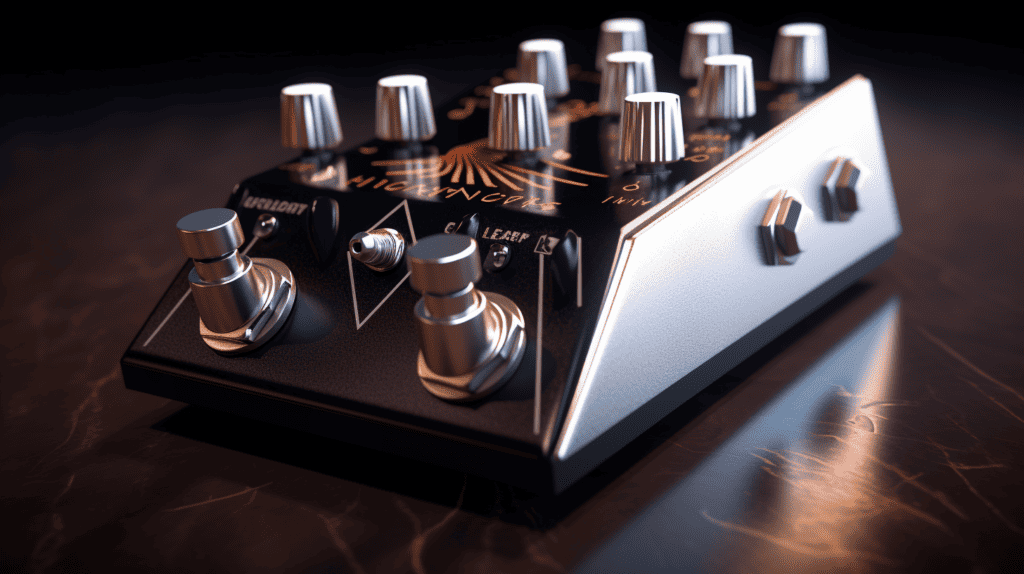Have you ever strolled through Guitar Center or searched the online marketplace for that ideal addition to your guitar setup, only to be left bewildered by the hefty price tag? Believe me, I empathize. Particularly when considering guitar pedals, the numbers on those price tags can be baffling. Let’s unravel this mystery together, exploring the question – why are guitar pedals so expensive, and what drives the guitar pedals cost?
The Craftsmanship Behind Guitar Pedals
Upon first look, a guitar pedal appears as a simple metal box adorned with a few knobs and switches, right? However, under that humble exterior lies a complex world of craftsmanship and intricate engineering.
Guitar pedals, especially the expensive pedals, aren’t simply churned out on a mass production line. They’re meticulously crafted by skilled technicians, often by hand. The craftsmanship that goes into the typical guitar pedal requires time and skill, and this is reflected in the cost.
Moreover, certain pedals like delay pedals or distortion pedals require specific, costly components. For instance, analog pedals, specifically analog delay pedals, utilize ‘bucket brigade’ chips to create their warm, vintage echo effect. These chips are increasingly rare, contributing to the higher price.
The Impact of Branding and Reputation
Much like many products, branding plays a crucial role in the pricing of guitar pedals. Brands such as Boss, Electro-Harmonix, and Strymon have built their reputations over the years, synonymous with delivering top-notch quality and consistency. Consequently, they can command higher prices. These brands boast a vast following of dedicated customers who are willing to pay a premium for the trust that these pedal companies have cultivated in their products.
R&D and Innovation Costs

Research and Development (R&D) costs significantly contribute to the high cost of guitar pedals. Manufacturers are perpetually innovating, designing new circuit boards, and experimenting with unique sounds and effects. This continuous cycle of innovation requires substantial investment, which is inevitably reflected in the final product price.
Take Strymon, for instance. Their expensive guitar pedals offer incredible versatility and sound quality, achieved through cutting-edge digital signal processing and sophisticated algorithms. All this technology comes at a cost – a cost that guitar players looking for the best guitar sound quality are often willing to bear (admittedly, not all of us).
The Boutique Pedal Factor
In recent years, we’ve seen a surge in the popularity of boutique pedals. These pedals are typically crafted by small companies, focused on creating unique, high-quality effects that distinguish them from the mass-produced ones. These boutique pedal manufacturers often use superior components and offer hand-wired construction. They might also provide custom modifications or unique features, thereby increasing the cost. Additionally, being small-scale operations, they can’t leverage economies of scale as larger pedal manufacturers can, leading to pricier tags. But for many guitarists, the unique tones and the particular sound these pedals offer are worth every cent.
Built to Last: A Matter of Build Quality
Most high-end guitar pedals are designed to endure the rigors of touring and regular use. These sturdy, quality guitar pedals feature casings often made from durable materials. Inside, their internal components are securely mounted to survive rough handling, from the frequent stomps of an enthusiastic guitar player to the perils of travel.
Moreover, many pedal manufacturers stand behind their products with robust warranties. They offer to repair or replace pedals if they fail, assuring the buyer that a few bucks more spent on their product will provide peace of mind.
Market Dynamics: Supply and Demand
Like any product, guitar pedals are subject to the laws of supply and demand. Limited-edition or discontinued pedals become highly sought-after collector’s items with prices to match. Some players are willing to pay a premium for these unique pieces of gear to capture a particular sound. Simultaneously, certain pedals, like the famous ‘Klon Centaur’ overdrive pedal, have gained almost mythical status among guitarists. This high demand, which often outstrips the supply, results in elevated prices.
The Trade-Off: Quality vs Price
As musicians, the struggle between desiring superior quality and managing budget constraints is real. This dilemma becomes pronounced when navigating the world of guitar pedals. Sure, there are inexpensive pedals in the market, and some of them, like cheaper pedals from brands like Behringer and Donner, do a decent job. But there’s no denying that in most cases, you get what you pay for.
Sound quality, durability, and versatility – these are the areas where high-end, expensive pedals shine. Investing in a good pedal can elevate your guitar tone and offer you a world of sonic possibilities. And while the initial cost might seem steep, these pedals often prove their worth in the long run.
The Resale Value of High-End Pedals
Another factor worth considering when contemplating the high cost of guitar pedals is their resale value. Good quality pedals, especially from reputable brands or boutique manufacturers, tend to hold their value well in the used market.
So, if you ever decide to upgrade your gear or if your musical tastes change, you can sell your old pedals and recoup a significant portion of your investment. Some rare or vintage pedals may even appreciate in value over time!
Tone Chasing: A Priceless Endeavor

There’s a certain allure to the quest for the perfect tone. It’s an exhilarating journey of exploration and discovery, and guitar pedals are an integral part of this adventure. With each pedal offering a unique sound and color, the tonal possibilities are practically endless. This makes the pursuit of the perfect guitar sound well worth the extra cost.
High-end guitar pedals, with their wide range of effects and superior sound quality, offer a sonic playground for musicians. These tools allow us to shape and refine our sound, bringing our creative vision to life. The joy of finding that perfect tone, the thrill of experimenting with unique effects – these experiences are, in many ways, priceless.
Ultimately, the cost of a guitar pedal, like any musical gear, is an investment in your musical journey. It’s not about possessing the most expensive gear; it’s about finding the right tools that help you express your musical ideas most effectively.
Striking a Balance: Budgeting for Your Pedalboard
Building a pedalboard can indeed be an expensive endeavor. But with a bit of strategic planning, it’s possible to strike a balance between quality and affordability.
One strategy is to prioritize your purchases. Start with the basics – an overdrive or distortion, a delay, and a reverb pedal. These form the foundation of most pedalboards and can cover a wide range of tones. Invest in good-quality pedals for these essential effects, and then gradually expand your collection as your budget allows.
Another approach is to mix and match. Invest in high-end pedals for the effects you use most frequently or the ones that significantly shape your sound. For the rest, you can opt for more affordable options. This way, you get the best of both worlds without breaking the bank.
Remember, a guitarist’s journey is unique, and so is their pedalboard. What works for someone else might not necessarily work for you. Take your time, do your research, and most importantly, trust your ears. Your pedalboard should serve your music, not the other way around.
In the grand scheme of things, guitar pedals, no matter how expensive, are tools that serve a purpose. They help articulate our musical ideas and create soundscapes that define our sonic identity. Their value lies not just in their price tags but in their ability to inspire us, push our creative boundaries, and enable us to express ourselves through music. At the end of the day, it’s not about the cost, but how you use it to create something meaningful.
Comparing Four Popular Guitar Pedals
Now, let’s compare four of the most popular guitar pedals in the market. We’ll consider aspects like the types of effects they offer, their features, and the value they provide for their cost. Keep in mind, all these pedals have been praised by guitarists worldwide, and the choice between them will largely depend on your individual preferences and needs.
Ibanez Tube Screamer: The Classic Overdrive

The Ibanez Tube Screamer is a classic. It’s known for its smooth, creamy overdrive, and its use spans nearly every genre, from blues and rock to country and metal. The Tube Screamer is renowned for its ability to add warmth and character to your tone without dramatically altering it.
Key features include a simple three-knob layout (Tone, Level, and Overdrive), and its bright green casing is instantly recognizable. It may not be the cheapest pedal on the market, but many guitarists swear by its sound and versatility, making it a worthy investment for any pedalboard.
Boss DS-1 Distortion: The Rocker’s Choice
The Boss DS-1 Distortion pedal is another staple in the industry. From its bright orange case to its hearty, saturated distortion, the DS-1 is known for providing edgier tones. It’s the go-to choice for rock and metal players looking for that extra bite in their sound.
Like the Tube Screamer, it features a three-knob layout (Tone, Level, and Distortion), allowing for a wide range of tones. Thanks to Boss’s reputation for building sturdy, reliable pedals, you can count on the DS-1 to last.
Electro-Harmonix Big Muff Pi: The Fuzzy Beast
The Electro-Harmonix Big Muff Pi is the pedal for those who crave thick, fuzzy distortion. Its sustain has become the stuff of legends, making it a favorite among rock and grunge players.
The Big Muff Pi comes equipped with Volume, Tone, and Sustain knobs for shaping your sound. While it is a bit larger compared to other pedals, its unique tone and sustained distortion make it a cult favorite.
Strymon Timeline: The High-End Delay Powerhouse
Moving away from overdrive and distortion, the Strymon Timeline is a high-end delay pedal offering unparalleled sound quality and versatility. With 12 different delay types and a slew of customizable parameters, it’s the stuff of sound designers’ dreams.
However, the Timeline is one of the more expensive pedals on the market. But for many players, its depth of features, superior sound quality, and creative possibilities justify the price.
These four pedals offer a range of tones and come at different price points. Choosing between them would depend on what you want in your tone, your budget, and the music you play. Remember, a pedal doesn’t have to be expensive to be good, and at the end of the day, the best pedal for you is the one that helps you express your musical ideas most effectively.
Boutique Pedals: The Artisan Touch

As we continue our exploration into the question, “Why are guitar pedals so expensive?” we enter the domain of boutique pedals. These are often considered the cream of the crop, the standout gems in the guitar pedal world. Boutique pedals are usually handcrafted by smaller companies with a strong focus on quality, uniqueness, and attention to detail.
Companies like Strymon, JHS Pedals, and EarthQuaker Devices have carved out a name for themselves in the industry. Their pedals are sought after by guitarists of all kinds – from garage hobbyists to rock stars headlining stadiums. The passion and craftsmanship that goes into creating these boutique pedals contribute to their uniqueness and high cost.
Take the Strymon Timeline I mentioned earlier, for example. This premium digital delay pedal has nearly become a staple among professional guitarists. It provides exceptionally high-quality, studio-grade delay sounds, with an almost endless variety of delay types and customization options. However, creating this intricate level of detail requires painstaking attention and a high level of expertise, leading to more design time, complex circuitry, and elevated production costs. For those seeking the perfect tone, the cost is deemed worthwhile.
The Impact of Premium Parts and Materials
Let’s dive into the details of these pedals. The components constituting a guitar pedal – capacitors, resistors, ICs, wires, potentiometers, and more – significantly influence the pedal’s sound. Higher-quality components generally result in a better, more reliable sound and a longer lifespan. However, these premium parts come with a steeper cost.
For example, some boutique pedal makers prefer old-school ‘through-hole’ components over the more modern ‘surface-mount’ types. Although through-hole components are generally considered higher quality, they are also pricier and more time-consuming to install, inevitably driving up the pedal’s cost.
The Price of Innovation
Another often overlooked aspect of guitar pedal pricing is the cost of innovation. Companies pushing the boundaries of what guitar pedals can do often pour a substantial amount of money into research and development.
Consider the company Meris, for instance. Their Ottobit Jr. pedal is a unique bit-crusher and sequencer pedal, unlike anything else available. Creating such innovative and unique products requires extensive research, testing, and a substantial amount of trial and error. These costs ultimately factor into the final price of the pedal.
Conclusion: The Worth Beyond the Sticker Price
That concludes our exploration into the query, “Why are guitar pedals so expensive?” As illustrated, the cost of a guitar pedal extends beyond a mere price tag. It encompasses the labor, ingenuity, and skill dedicated to fabricating these wondrous instruments of tone. It highlights the caliber of the materials and components employed. It underscores the originality and novelty that the pedal introduces to your music.
However, the most significant worth of a guitar pedal is embedded in the delight it furnishes to you as a guitarist. The contentment derived from fine-tuning that ideal tone. The exhilaration of tinkering with novel sounds. The adrenaline rush of executing that solo with the optimal blend of overdrive or delay.
Thus, when you find yourself yearning for that high-end boutique pedal, remember what you’re genuinely investing in. It’s not just a piece of equipment – it’s a contribution to your tone, your melodies, and your fervor for music.
Frequently Asked Questions
Q1: Why are guitar pedals so expensive?
A1: Several factors contribute to the cost of guitar pedals. These include the quality of components used, the intricacy of the circuit design, the costs of research and development for innovative pedals, the labor involved in production (especially for handcrafted boutique pedals), and the brand reputation.
Q2: Are expensive guitar pedals worth the price?
A2: The value of an expensive guitar pedal depends largely on the individual guitarist. For some, the unique tones, superior sound quality, and added versatility of high-end pedals justify the cost. For others, particularly beginners or those on a budget, less expensive pedals might be more suitable.
Q3: Do I need to buy expensive pedals to get a good sound?
A3: While expensive pedals often offer superior sound quality and versatility, good sound can also be achieved with less expensive pedals. Factors like your playing technique, the quality of your guitar and amp, and your understanding of how to use effects can also greatly influence your sound.
Q4: Why do some guitarists prefer boutique pedals?
A4: Boutique pedals are often favored for their unique tones, high build quality, and the attention to detail that comes from being handcrafted. These pedals are usually produced in smaller numbers and offer sounds and features that are not commonly found in mass-produced pedals.
Q5: What makes boutique pedals more expensive than mass-produced ones?
A5: Boutique pedals are typically handcrafted, meaning they require more labor to produce. The companies that make these pedals often focus on quality over quantity, using premium components and designing intricate circuits. The uniqueness and innovation that these pedals offer also add to their value.
